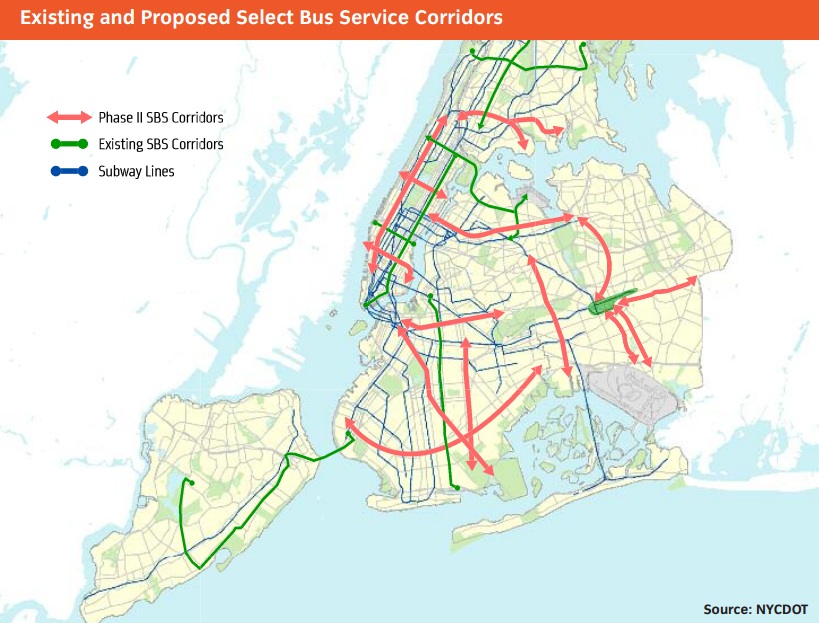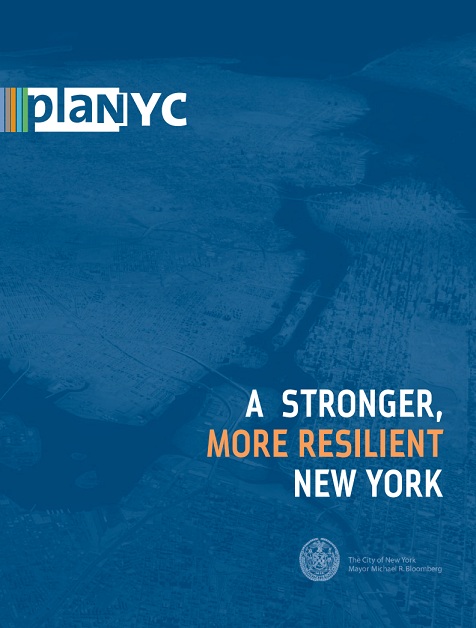
The coverage of Mayor Bloomberg’s $20 billion storm resiliency plan for New York City has largely focused on big ticket items like building levees, flood walls and berms and even the potential for a “Battery Park City East” called Seaport City. But while the Mayor didn’t mention transit, biking or walking in his presentation yesterday, that doesn’t mean the plan overlooks transportation ideas and strategies to make New York City and the region more resilient against future storms and the impacts of climate change.
The plan highlights the existing challenges the region faces by revisiting the devastation wrought by Superstorm Sandy (roughly $8.7 billion to the transportation system alone). Also highlighted was the resiliency of every day New Yorkers who biked to work in record numbers when the transit system was down, and the temporary services like the NYCDOT and MTA bus bridges, additional ferry services and HOV restrictions, that helped get the City moving again.
While the plan talks about protecting existing infrastructure from future events, the most interesting plan aspects, however, were the strategies and recommendations for restoring the system in the wake of future extreme weather events and the identification of the new services needed to increase system redundancy and resiliency. Some of the highlights include:
System Restoration
- Improved bus bridges and increasing access to Long Island Rail Road and Metro-North services for intra-city mobility
- Expanded ferry services
- Standardized plans from NYCDOT and NYPD for HOV requirements
- Installation of new pedestrian and bicycle facilities, including the use of “special lanes on the East River Bridges and their approaches, and lanes that provide access to ferry landings”
- Expansion of bike share to areas that are particularly vulnerable to climate change disruptions and power outages.
New and Expanded Services
- Expanded Select Bus Service network
- Expanded network of bus priority strategies for express, local and intercity buses on arterial highways (the City intends to work with the New York State Department of Transportation to include 15 miles of bus priority corridors along the regional expressway network)
- Expanded ferry service citywide using NYC Economic Development Corporation’s Comprehensive Citywide Ferry Study as a guide.
The plan is very careful to temper expectations about moving forward with any of these initiatives by including “subject to available funding” throughout the report. But unlike Governor Cuomo’s Sandy Commission report, which largely left out the difficult conversation of how to fund smart transportation initiatives, yesterday’s plan release outlined several potential funding strategies. The plan identifies numerous traditional funding resources including, Sandy recovery dollars, the City’s Capital Program, and additional federal sources like Community Development Block Grants.
However, the plan also takes the opportunity to make a “soft pitch” for Sam Schwartz’ MoveNY plan which would toll the existing free bridges along the East River and reduce tolls on other bridges like the Verrazano Narrows, the Whitestone and the Throgs Neck. The tolling plan is expected to generate $1.5 billion in new revenues and leverage bonding of $12-$15 billion and could be used to fund “bridge maintenance, transit improvements and a state of good repair for MTA and City transportation assets.”


Like his gun-control legislation, post-Newtown, Cuomo’s Sandy disaster package was not well thought out and prematurely released.
I noticed in this report it recommends that when people evacuate to higher ground they TAKE THE CAR WITH THEM! This is easy to implement–just beat up on the auto insurers. They’ll get compliance.
243,000 vehicles were lost(NY/NJ/CT) and were not available when they were sorely needed.
[…] missing from the plan are infrastructure costs related to Superstorm Sandy resiliency (which a footnote states are “in the process of being finalized”), bicycle and pedestrian […]
[…] chance to plan and rebuild smarter. The last 12 months have seen a variety of new ideas about how to weather-proof buildings and infrastructure. Now that we’ve seen what kind of […]